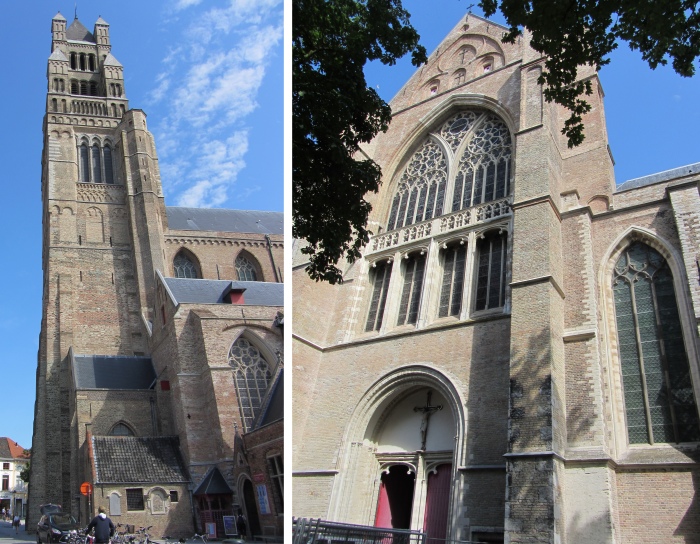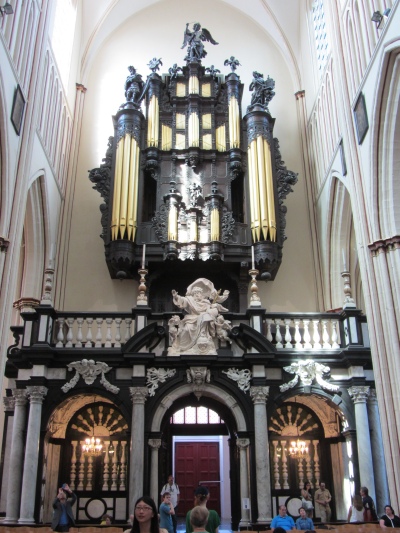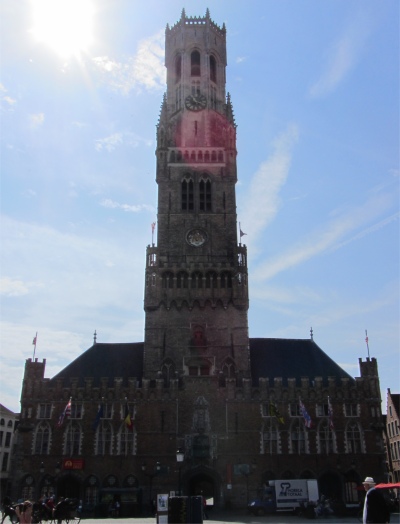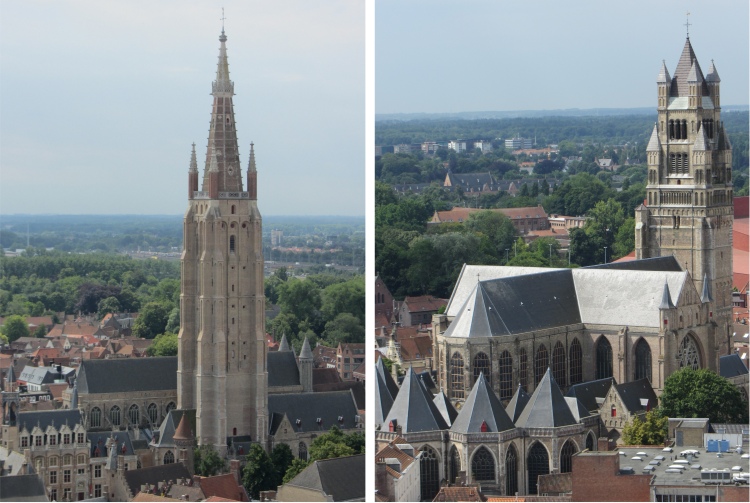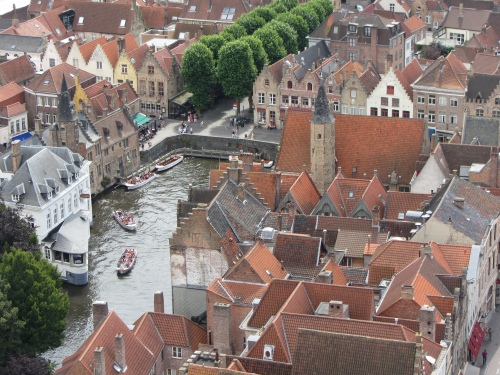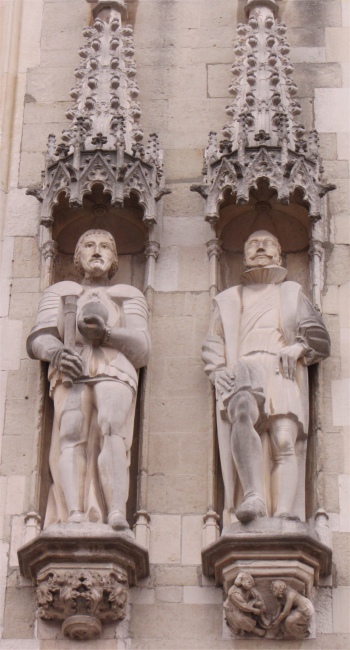
Stadhuis Niche Statues
|

Stadhuis
|
As we walked up Oostmeers, sharing the pavement with trucks that were delivering building supplies, we could feel ourselves slipping back in time. I caught sight of a large impressive tower, I must see that I thought. Then, we broke through a side street to find ourselves dwarfed by a large cathedral, Sint-Salvatorskathedraal (St. Saviour's Cathedral).

Chambers or Oude Griffie
|
This impressive building started out as a common parish church founded in the 10th century, and wasn't completed until the 15th century. At that time, the Sint-Donatius Church, which was located at the very heart of Bruges opposite of the town hall, was the most important religious building of the city. At the end of the 18th century, the French inhabitants of Bruges threw out the bishop and destroyed the Sint-Donatius Church, his residence. In 1834, shortly after Belgium's independence in 1830, a new bishop was installed in Bruges and the Sint-Salvator church obtained the status of cathedral. In 1839 a fire destroyed the roof of the cathedral. William Chantrell, an English architect, famous for his neo-Gothic restorations of English churches, was asked to restore Sint-Salvator to its former glory. At the same time he was authorized to make a project for a higher tower, in order to make it taller than that of the Onze-Lieve-Vrouwekerk (Church of our Lady). This change of status prompted lots of ecclesiastical rumblings - nearby Onze Lieve Vrouwekerk was bigger and its spire higher - and when part of St Salvators went up in smoke in 1839, the opportunity was taken to make its tower higher and grander in a romantic rendition of the Romanesque style. Instead of adding a Neo-Gothic tower extension, Chantrell chose a very personal Romanesque design. After completion there was a lot of criticism and the royal commission for monuments (Koninklijke Commissie voor Monumenten), without authorization by Chantrell, had placed a small peak on top of the tower because the original design was deemed too flat.
We took some time out to have a look around the interior of the cathedral. The impressive organ caught my eye as soon as I walked in. Eight tapestries hung in the building, all manufactured in Brussels by Jasper van der Borcht in 1731. The designs were based on a matching set of paintings by Jan van Orley. The tapestries had been commissioned by bishop Hendrik van Susteren for Sint-Donatius.
As we walked down Steenstraat on our way to the Grote Markt, I stopped at Simon Stevinplein to cast my eyes over Simon Stevin Square towards the nearby Onze Lieve Vrouwekerk. I could see clearly the competition its tower and spire posed to Sint-Salvatorskathedraal. Simon Stevin Square itself was a pleasant enough square with lots of shops and restaurants around its perimeter. In the middle of the square stood the statue of Simon Stevin: a Dutchman, mathematician, physicist and engineer.
A short distance away, via the obstacle of several hundred tourists, lay the Grote Markt. This 1 hectare square was located in the commercial medieval heart of the city. The city administration was located in the nearby "Burg" square.

Entrance to Basilica of the Holy Blood
|
The most striking building on the market square was undoubtedly the imposing 12th-century belfry, that once stood as a symbol of freedom and wealth. The building was expanded from the 13th till the 15th century. The octagonal highest part of the tower had housed the carillon since the 15th century.
On the Northern side of the Markt stood the Provincial Court, originally the Waterhall. It stood on the site where the medieval "water halls" used to stand. This was a covered hall where ships could unload their products for storage in the halls or for direct sale on the adjacent market. After the destruction of the water halls in 1787, a new complex of houses was built there in classical style. This style was considered very modern in a town that was basically built in late-gothic style. In 1850 the provincial government bought the complex, enlarged it and made it the seat of the provincial institutions. The members of the catholic and traditionalist political parties rejected the building as "unfit for the beautiful Gothic Bruges". In 1878 a fire destroyed most of the building, thus allowing different groups to take their chance to have it reconstructed in 1887 in neo-gothic style, the "house"-style of the catholic party. On the left side of the complex was the house of the Governor of the Province of West-Flanders.
The rest of the market was surrounded by beautiful 17th century buildings that faced the square occupied by restaurants, cafes and shops located in former private houses and guild houses, some with 15th century façades.
In the centre of the market stood the statue of Jan Breydel and Pieter de Coninck. The statue not only honoured these two leaders of the "Battle of the Golden Spurs" which took place on the 11th July 1302, it was perhaps more so a clear statement of the political leaders of the 1880's that the cause for Flemish emancipation was something that the Belgian government had to take notice of. Both Breydel and de Coninck participated in the 1302 uprising of the Flemish against the occupation by the French king. This battle was also the central theme of the book "De Leeuw van Vlaanderen" (the Lion of Flanders) written by Hendrik Conscience in 1838. He romanticised the Flemish uprising and it became a symbol of the Flemish movement which fought for recognition of the Dutch language and Flemish culture in the French-language dominated Belgium of the 19th century.

Fresh Fish Today
|
In 1995 the market was completely refurbished and was now one of the most attractive parts of the city. Parking in the square was removed and the area became mostly traffic-free, thus being more celebration friendly. The renovated market was reopened in 1996 with a concert by Helmut Lotti. However, the market wasn't exactly free of "traffic". Numerous horse and carriages were patiently lined up to take tourists on guided tours around the city. The guides, male and female, sat on their carriages, dressed in black and all wearing hats of mainly the bowler variety, chatting away to each other or to the occasional tourists who got close. Cameras clicked incessantly, and the earthy aroma of horse manure emanated from the canvas poo-catchers brushing their rear ends.
After taking the view in, we rested our feet in a cafe in what was once Cranenburg House, where emperor Maximilian of Austria was incarcerated in 1488. This was one of the beautiful restored buildings. Rex and Meryl fancied a spot of lunch, I fancied climbing the belfry, an activity they had already participated in on a previous visit, so we agreed to meet up later and off I went.
The Belfry of Bruges or Belfort was one of the city's most prominent symbols. The Belfry was also known as "Halletoren" (Tower of the Halls). It housed a treasury and municipal archives, and served as an observation post for spotting fires and other dangers. The original cloth hall and tower dated from 1240. The first tower, however, was destroyed by fire in 1280. At the time of the fire the four wings of the cloth hall already existed, as well as the two square segments of the belfry. The octagonal upper stage of the belfry was added between 1483 and 1487, and capped with a wooden spire bearing an image of Saint Michael, banner in hand and dragon underfoot. The spire did not last long: a lightning strike in 1493 reduced it to ashes, and destroyed the bells as well. A wooden spire crowned the summit again for some two-and-a-half centuries, before it too, fell victim to flames in 1741. The spire was never replaced again, thus making the current height of the building somewhat lower than in the past; but an openwork stone parapet in Gothic style was added to the rooftop in 1822. A poem by Henry Wadsworth Longfellow, titled "The Belfry of Bruges," refers to the building's chequered history:
"In the market-place of Bruges stands the belfry old and brown;
Thrice consumed and thrice rebuilded, still it watches o'er the town."
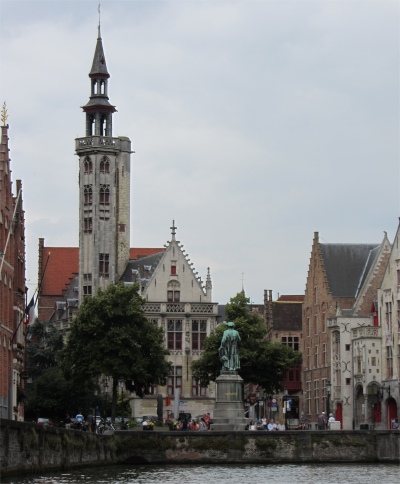
Poortersloge Watched Over by Jan van Eyck in Jan van Eyck Square
|
I entered the former market hall, a rectangular building with an inner courtyard, and started off up the narrow steep staircase on the 366 step climb to the top of the 83-metre high building, pausing for a while at the treasury and archive floor to soak up more of the city's history. Nearing the top of the building I stopped to take a look into the carillon room. The bells in the tower regulated the lives of the city dwellers, announcing the time, fire alarms, work hours, and a variety of social, political, and religious events. Eventually a mechanism ensured the regular sounding of certain bells, for example indicating the hour. In the 16th century the tower received a carillon, allowing the bells to be played by means of a hand keyboard. Starting from 1604, the annual accounts record the employment of a carilloneur to play songs during Sundays, holidays and market days. In 1675 the carillon comprised 35 bells, designed by Melchior de Haze of Antwerp. After the fire of 1741 this was replaced by a set of bells cast by Joris Dumery, 26 of which were still in use. There were 48 bells at the end of the 19th century, but today the bells numbered 47, together weighing about 27.5 tonnes. The bells ranged from weighing two pounds to 11,000 pounds. On the quarter hour the 47 bells sounded, by mechanical means, played by movable tabs on a giant copper drum. Concerts were played by a carillonist, who played the manual keyboard with fists and feet, rather than with fingers.
At the top I surveyed the city and its surroundings with a 360° view, and it gave me the opportunity to observe how compact the city was. The climb was well worth it. It took me three times as long to descend the narrow staircase than climb it. In front of me was a middle-aged English couple who insisted on letting all and sundry up before venturing down a few more steps. I bit my lips; at times I am not a patient man.
I met up with my partners in crime, and we headed off to the Hallen part of the Belfort complex, which now housed exhibitions, in particular we wanted to visit the permanent Museum-Gallery Xpo: Salvador Dalí, Marquis de Púbol (Dalí's full name was Salvador Felipe Jacinto Dalí y Domènech, Marqués de Púbol). As soon as we entered the exhibition room, my senses reeled with the colour scheme, the medieval hall had been transformed into a Dalínian showroom, a work of art in itself. The Grand Opera Decor of Bruges, whose artistic director and CEO is Barron Saint Mythelfinger, had developed and designed the concept and interior decorations of the new Museum-Gallery Salvador Dalí. Barron Saint Mythelfinger, the self-proclaimed "360° sovereign artist-designer", was the right man at the right time and place. He not only created paintings and bronzes, but also decorated interiors, designed furniture and carpets. As a true Dalí aficionado, Mythelfinger worked through genial exaggeration. The Museum Gallery had turned out to be a dazzling work of art for that reason. The visitor moves through the grand medieval gates into a number of sensual boudoirs. The decorator had lavishly applied Dalí's favourite colours: gold, mother-of-pearl and (evidently) shocking pink, which enhanced the erotic atmosphere of the works on display.
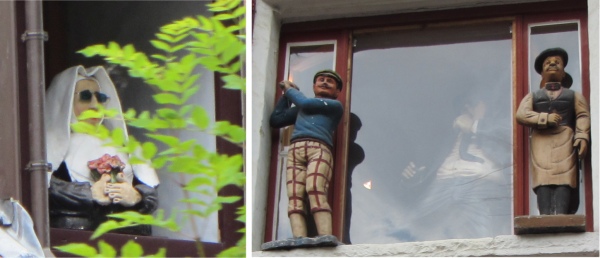
Silent Watchers of the Canals
|
A large collection of watercolours, drawings, paintings of various techniques, illustrations of various texts, books, sculptures, sculptures and famous works of graphic art were on display. The collection was not for the faint-hearted, he managed to turn everything into a quite obvious sexual connotation. What were my views on the works on display? To me the quality of draughtsmanship was superb. This was a guy who could boldly and confidently portray his ideas with simple lines of stunning clarity and ease; he was indeed an accomplished artist. However, what his offerings meant I have no idea, I was not on the same planet, and I was at a loss. Perhaps this reflects Dalí's opinion, any true artist should be able to express his wildest and most chaotic experiments in a classic way. He himself never avoided uncontrolled experimenting. He even claimed to have painted by means of a revolver, which goes way beyond what action painters such as Jackson Pollock did years later. "The madman thinks he is sane. I know I am mad" is one of his thought-provoking quotes, alluding to Descartes. And like Hamlet he adds: " 'it's madness, and yet there's method in it." Scattered around the exhibition were various Dalian quotes, such as,
"I AM IN A PERMANENT STATE OF INTELLECTUAL ERECTION" or
"THERE ARE SOME DAYS WHEN I THINK I'M GOING TO DIE FROM AN OVERDOSE OF SATISFACTION", giving an insight into the man's inner thought mechanisms.
It was all very thought-provoking. For anyone wishing to visit the exhibition, it was permanent, but the collections would be altered year by year, so as to achieve more variety in the displays.
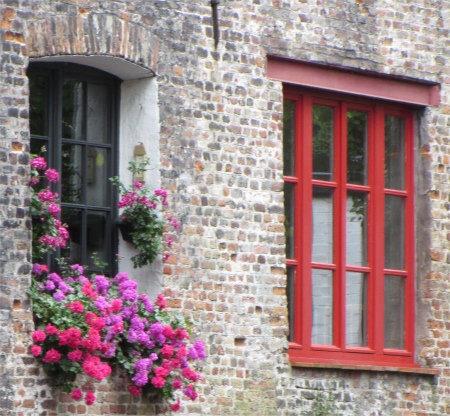
Splash of Colour by the Canal
|
A short distance away from the Grote Markt, the commercial heart of medieval Bruges, stood the Burg or Castle Square, the heart of administrative Bruges. It was here that Count Baldwin I had a fortified castle built to protect the area against the rampaging Normans and Vikings. The castle had long since disappeared as well as the main religious building of Bruges, the St. Donatius church, erected around the year 900, which stood opposite the town hall. On the site of the church stood a little wall, a partial reconstruction of the choir walls of the church. It was built here after the foundations of St. Donatius had been found in 1955. The central part of the church was octagonal, much like the cathedral of Charlemagne in the German city of Aachen on which it was modelled. The original prayer house of the year 900 was replaced in the 12th century by a church in Romanesque style. This version of the St. Donatius church was destroyed in 1799 during the French occupation of the Southern Netherlands. Some of the art treasures went to other churches such as Sint-Salvatorskathedraal. Several famous people were buried in St. Donatius : the English princess Gunhilde (1087), the Flemish painter Jan van Eyck (1441) and the Spanish philosopher Juan Luis Vives (1540). The Burg square was really a showcase of different European architectural styles: Gothic (Stadhuis), Renaissance (Chambers), Gothic and Gothic Revival (Basilica of the Holy Blood), and Neo-Classical on the facade of the former Court of Justice, a part of the Mansion of Bruges (Landhuis van het Brugse Vrije).
One of the most beautiful buildings of Bruges could be seen here, the gothic Stadhuis or town hall dating from 1376. One of the oldest town halls in the Low Countries and one of the first secular Gothic buildings,
the Stadhuis was built on the site of the fortified castle of Count Baldwin I (Boudewijn). In the front facade were six gothic windows. In addition there were 48 niches for statues. The original statues (biblical figures and counts of Flanders) were demolished during the aftermath of the French Revolution. Their 19th century replacements had also already been changed for more modern versions.
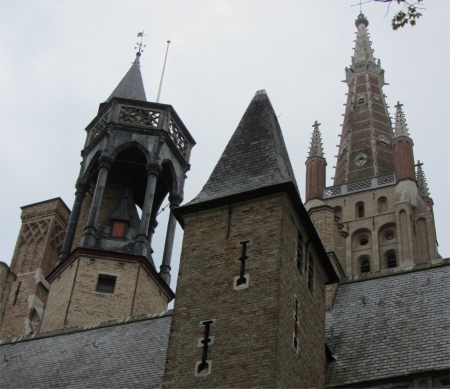
A Different View of Onze Lieve Vrouwekerk from the Canal
|
Next to the gothic town hall stood the Chambers or Oude Griffie (Old Civil Registry), in renaissance style (1534). The decorative gilded figurines representing Justice, Moses and Aaron, were also smashed to pieces in 1792, but later renovated. The building was used as a Peace Court between 1883-1984.
Left of the Oude Griffie was the Court of Justice (not the judiciary which was housed in more modern quarters on the edge of town). The "old" Court of Justice, built in neo-classicist style (1722) now housed some offices of the town council including the Tourist Information Centre.
In the south-west corner of Castle Square stood the Basilica of the Holy Blood (granted Basilica status in 1923). It was originally built in 1134-1157 as the residential chapel of the Count of Flanders, Thierry of Alsace, who brought the Relic of the Precious Blood back to Bruges from the Holy Land at the end of the Second Crusade (1148). The highly venerated Relic of the Precious Blood has been carried through the streets in an annual procession since 1303.
You can't come to Bruges without taking in a canal trip, and since our feet were getting tired, a 30 minute break was most welcome and viewing the city from the water would give it a totally different feel. We headed down Blinde-Ezelstraat (Blind Donkey Street), so named because the donkey which used to service the mill here was blindfolded so that it would not be able to look at the same route every day and feel the ennui, and soon we were with forty other souls on a low motor boat traversing the canals at a brisk pace. The captain gave a running commentary in Dutch, French and English, but the noise of the engine drowned out his dulcet tones.
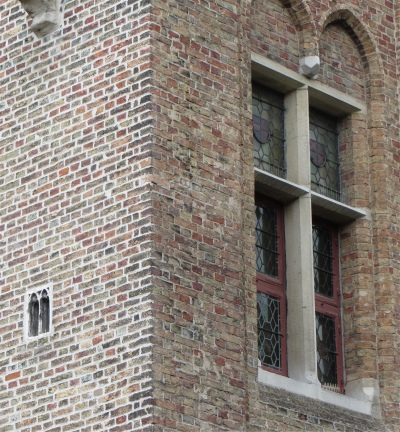
Spot the Smallest Spy Window
|
Because of its canals Bruges was often called "The Venice of the North". In the Middle-Ages, the waterways to Bruges had to be regularly adapted and enlarged to allow large trade ships to reach the city. Already in the 12th century the cargo was mostly brought to the outports of Damme and Sluis, two small medieval cities that still exist today. All through the golden era of Bruges the rivers and canals were constantly dredged. Inside the city the Reie river had been turned into a network of canals that enabled the traders to bring their products to the large Water Halls at the Markt. Inside the Water Halls the goods were stored or sold directly. After they had passed Damme, the ships entered Bruges on the site where now the Dampoort-complex was situated. The "Dampoort" was one of the city gates that allowed entrance to the city. On the way to the centre the sailors followed the canals which were now called "Langerei", "Potterierei" (where the shipyards were located), "Spiegelrei", and "Spinolarei". From the Spinolarei we saw the Poortersloge (Burgher's Lodge), built in the early 15th century, which was the meeting place for the richer and more important members of the Bruges society. Until 1715 it was the seat of "The Society of the White Bear," the chivalrous jousting association of Bruges. The Academy of Fine Arts had also resided here and to date the National Archives were housed here. Very often concerts, festivities and banquets were organized in this building. In front of it lay the Jan van Eyck square with the statue of this great Flemish painter who lived and died in Bruges (1444).
We sped past overhanging weeping willows under which ducks frolicked, under many of the city's fifty plus mossy bridges, past St John's Hospital that now housed a museum, having served as a hospital from the time of the Crusades. Many picturesque houses had no windows or had covered panes, and our guide told us the reason: a "window tax" once imposed on the town's people. Hmm... did Pitt's influence stretch this far? We meandered down canals, looking at palaces, churches, houses with gables covered with ivy and "spy windows". Meryl spotted the smallest Gothic window in the city, of course a spy window.
Suitably rested, we strolled past a flea market, explored some more on foot and stumbled upon some alms houses and a convent. The city was dotted with many simple whitewashed alms houses, also called Godshuizen, that locals called "Charity frozen in stone" - houses made by charitable institutions, rich merchants and churches as a safe refuge for widowers and spinsters. Today these were private residences.
